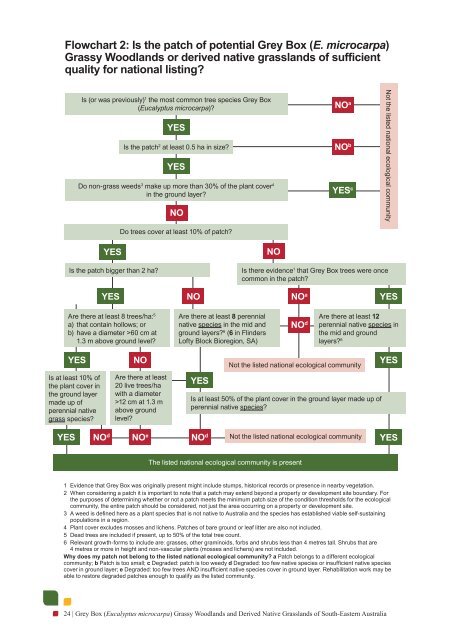Grey Box (Eucalyptus microcarpa) Grassy Woodlands and Derived ...
Grey Box (Eucalyptus microcarpa) Grassy Woodlands and Derived ...
Grey Box (Eucalyptus microcarpa) Grassy Woodlands and Derived ...
You also want an ePaper? Increase the reach of your titles
YUMPU automatically turns print PDFs into web optimized ePapers that Google loves.
Flowchart 2: Is the patch of potential <strong>Grey</strong> <strong>Box</strong> (E. <strong>microcarpa</strong>)<br />
<strong>Grassy</strong> <strong>Woodl<strong>and</strong>s</strong> or derived native grassl<strong>and</strong>s of sufficient<br />
quality for national listing?<br />
Is at least 10% of<br />
the plant cover in<br />
the ground layer<br />
made up of<br />
perennial native<br />
grass species?<br />
YES<br />
Is (or was previously) 1 the most common tree species <strong>Grey</strong> <strong>Box</strong><br />
(<strong>Eucalyptus</strong> <strong>microcarpa</strong>)?<br />
YES<br />
Is the patch bigger than 2 ha?<br />
Are there at least 8 trees/ha: 5<br />
a) that contain hollows; or<br />
b) have a diameter >60 cm at<br />
1.3 m above ground level?<br />
YES<br />
Is the patch 2 at least 0.5 ha in size?<br />
Do non-grass weeds 3 make up more than 30% of the plant cover 4<br />
in the ground layer?<br />
NO d<br />
YES<br />
NO e<br />
YES<br />
YES<br />
Do trees cover at least 10% of patch?<br />
NO<br />
Are there at least<br />
20 live trees/ha<br />
with a diameter<br />
>12 cm at 1.3 m<br />
above ground<br />
level?<br />
NO<br />
NO<br />
Are there at least 8 perennial<br />
native species in the mid <strong>and</strong><br />
ground layers? 6 (6 in Flinders<br />
Lofty Block Bioregion, SA)<br />
YES<br />
24 | <strong>Grey</strong> <strong>Box</strong> (<strong>Eucalyptus</strong> <strong>microcarpa</strong>) <strong>Grassy</strong> <strong>Woodl<strong>and</strong>s</strong> <strong>and</strong> <strong>Derived</strong> native Grassl<strong>and</strong>s of south-eastern Australia<br />
NO<br />
The listed national ecological community is present<br />
NO a<br />
NO b<br />
YES c<br />
Is there evidence 1 that <strong>Grey</strong> <strong>Box</strong> trees were once<br />
common in the patch?<br />
Is at least 50% of the plant cover in the ground layer made up of<br />
perennial native species?<br />
NO d<br />
NO a<br />
NO d<br />
Not the listed national ecological community<br />
YES<br />
Are there at least 12<br />
perennial native species in<br />
the mid <strong>and</strong> ground<br />
layers? 6<br />
Not the listed national ecological community<br />
Not the listed national ecological community<br />
1 Evidence that <strong>Grey</strong> <strong>Box</strong> was originally present might include stumps, historical records or presence in nearby vegetation.<br />
2 When considering a patch it is important to note that a patch may extend beyond a property or development site boundary. For<br />
the purposes of determining whether or not a patch meets the minimum patch size of the condition thresholds for the ecological<br />
community, the entire patch should be considered, not just the area occurring on a property or development site.<br />
3 A weed is defined here as a plant species that is not native to Australia <strong>and</strong> the species has established viable self-sustaining<br />
populations in a region.<br />
4 Plant cover excludes mosses <strong>and</strong> lichens. Patches of bare ground or leaf litter are also not included.<br />
5 Dead trees are included if present, up to 50% of the total tree count.<br />
6 Relevant growth-forms to include are: grasses, other graminoids, forbs <strong>and</strong> shrubs less than 4 metres tall. Shrubs that are<br />
4 metres or more in height <strong>and</strong> non-vascular plants (mosses <strong>and</strong> lichens) are not included.<br />
Why does my patch not belong to the listed national ecological community? a Patch belongs to a different ecological<br />
community; b Patch is too small; c Degraded: patch is too weedy d Degraded: too few native species or insufficient native species<br />
cover in ground layer; e Degraded: too few trees AND insufficient native species cover in ground layer. Rehabilitation work may be<br />
able to restore degraded patches enough to qualify as the listed community.<br />
YES<br />
YES
















